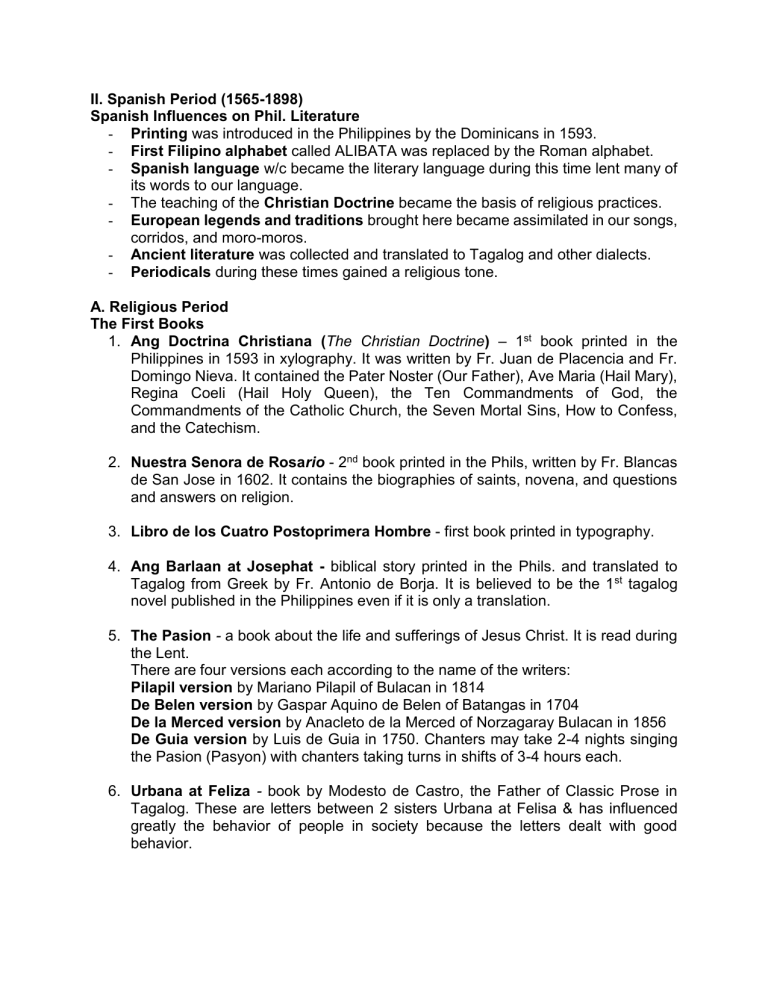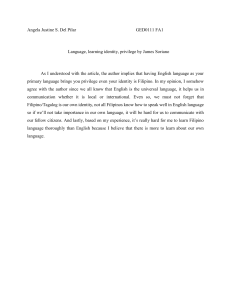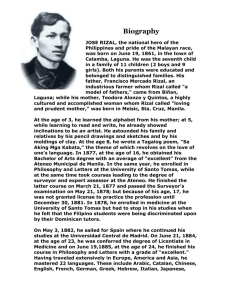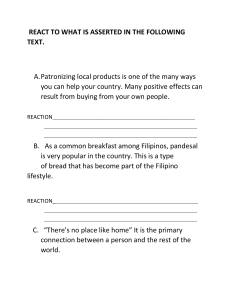Philippine Literature: Spanish Colonial Period
advertisement

II. Spanish Period (1565-1898) Spanish Influences on Phil. Literature - Printing was introduced in the Philippines by the Dominicans in 1593. - First Filipino alphabet called ALIBATA was replaced by the Roman alphabet. - Spanish language w/c became the literary language during this time lent many of its words to our language. - The teaching of the Christian Doctrine became the basis of religious practices. - European legends and traditions brought here became assimilated in our songs, corridos, and moro-moros. - Ancient literature was collected and translated to Tagalog and other dialects. - Periodicals during these times gained a religious tone. A. Religious Period The First Books 1. Ang Doctrina Christiana (The Christian Doctrine) – 1st book printed in the Philippines in 1593 in xylography. It was written by Fr. Juan de Placencia and Fr. Domingo Nieva. It contained the Pater Noster (Our Father), Ave Maria (Hail Mary), Regina Coeli (Hail Holy Queen), the Ten Commandments of God, the Commandments of the Catholic Church, the Seven Mortal Sins, How to Confess, and the Catechism. 2. Nuestra Senora de Rosario - 2nd book printed in the Phils, written by Fr. Blancas de San Jose in 1602. It contains the biographies of saints, novena, and questions and answers on religion. 3. Libro de los Cuatro Postoprimera Hombre - first book printed in typography. 4. Ang Barlaan at Josephat - biblical story printed in the Phils. and translated to Tagalog from Greek by Fr. Antonio de Borja. It is believed to be the 1 st tagalog novel published in the Philippines even if it is only a translation. 5. The Pasion - a book about the life and sufferings of Jesus Christ. It is read during the Lent. There are four versions each according to the name of the writers: Pilapil version by Mariano Pilapil of Bulacan in 1814 De Belen version by Gaspar Aquino de Belen of Batangas in 1704 De la Merced version by Anacleto de la Merced of Norzagaray Bulacan in 1856 De Guia version by Luis de Guia in 1750. Chanters may take 2-4 nights singing the Pasion (Pasyon) with chanters taking turns in shifts of 3-4 hours each. 6. Urbana at Feliza - book by Modesto de Castro, the Father of Classic Prose in Tagalog. These are letters between 2 sisters Urbana at Felisa & has influenced greatly the behavior of people in society because the letters dealt with good behavior. 7. Ang Mga Dalit kay Maria - collection of songs praising the Virgin Mary written by Fr. Mariano Sevilla, a Filipino priest. Popular especially during the May time “Flores de Mayo” festival. LITERARY GENRES Poetry 1. The Pasyon Ang Mahal Na Pasion Ni Jesu Christong P. Natin Na Tola - 1st known pasyon in the country - written by Gaspar Aquino de Belen in 1704. 2. Metrical Romances (Awit and Corrido) a. Awit - set in dodecasyllabic verse. They are fabricated stories from writers’ imagination although the setting and characters are Europeans. They refer to chanting. Florante At Laura by Francisco Baltazar (Prince of Tagalog Poets) Kung siya mong ibig ako’y magdusa Langit na mataas aking mababata b. Corrido - in octosyllabic verse. They were usually based on European legends or tales. They refer to narration Ibong Adarna, Historia Famoso ni Berbardo del Carpio, Doce Pares ng Francia Lines from Ibong Adarna Oh, Birheng kaibig-ibig Ina naming nasa langit, Liwanagan yaring isip Nang sa layo’y di malihis. 3. Ladino Poems - Ladinos were the first Tagalog versifiers who saw print, natives who were highly literate in both Spanish and the vernacular. Among them were Fernando Bagongbanta and Tomas Pinpin. 4. Folk Songs Leron-Leron Sinta, Pamulinawen, Dandansoy, Sarong Banggi, Atin Cu Pung Singsing Prose The prose works of the period consisted mostly of didactic pieces and translations of religious writings in foreign languages, such as novenas and biographies of saints, and the linguistic works of the friar-lexicographers and grammarians. Barlaan at Josaphat/Josephat - tells the story of the conversion to Christianity of a young Indian prince, Josaphat, by the holy man, Barlaan; their pious lives, and holy death. Urbana at Feliza - most important didactic literature of this period Religious and Recreational Plays 1. Panunuluyan - tagalog version of the Mexican posadas. It is held on the eve of Christmas. It dramatizes Joseph and Mary’s search for lodging in Bethlehem. 2. Cenaculo - dramatization of the passion and death of Jesus Christ. 2 Kinds Cantada Hablada 3. Salubong/Panubong - an Easter play that dramatizes the meeting of the Risen Christ and His Mother. 4. Tibag (excavate) - depicts St. Helena/Elena’s search for the cross on which Christ died. 5. Carillo (Shadow Play) - dramatic entertainment performed on a moonless night during a town fiesta or on dark nights after harvest. Projecting cardboard figures before a lamp against a white sheet 6. Zarzuela/Sarswela - considered the father of the drama 7. Sainete - short musical comedy popular during 18th century. It is also an exaggerated comedy depicting scenes from everyday life with rustic or lower-class figures as characters. La India Elegante y el Negrito Amante (1836) by Francisco Baltazar. The Moriones - story of Longinus, a Roman soldier who was beheaded for proclaiming his belief in Christ and spreading in the community the miracle of the resurrection of Christ. The Moro-moro - comedia showing how the Mohammedans were defeated by some Divine Intercession and converted to Christianity. Karagatan - a poetic vehicle of a socio-religious nature celebrated during the death of a person. It comes from an old legendary practice of testing the mettle of young men vying for a maiden’s hand. The maiden’s ring, or any precious piece of jewelry, would be dropped into the sea, & the suitors would dive for it. Whoever retrieved it would have the girl’s hand in marriage. Duplo - replaced the Karagatan and considered as the forerunner of balagtasan. It is a poetic joust in speaking and reasoning. The performers consists of two teams, one composed of young women called dupleras or belyakes, & the other, of young men called Dupleros or belyakos. An elderly man- the harii- presides over the proceedings. Balagtasan - poetic joust or a contest of skills in debate on a particular topic or issue. Dung-aw - chant in free verse by a bereaved person beside the corpse of the dead. B. Rebellious Period The Propaganda Movement and the Literature of Protest - The objectives of this movement were to seek reforms and changes like the following: 1. To get equal treatment for the Filipinos and the Spaniards under the law. 2. To make the Philippines a colony of Spain. 3. To restore Filipino representation in the Spanish Cortes. 4. To Filipinize the parishes. 5. To give the Filipinos freedom of speech, of the press, assembly, and for redress of grievances. The Propagandists 1. Dr. Jose P. Rizal (Jose Protacio Rizal Mercado Alonzo y Realonda) - pen names were Laong Laan and Dimasalang. His Books and Writings Noli Me Tangere (Touch Me Not) - title from book of St. John. It is considered a novel of society El Filibusterismo - sequel of Noli. Known as a novel of politics Mi Ultimo Adios (My Last Farewell) - considered by critics as his poetic masterpiece. It is a poem he wrote while he was incarcerated at Fort Santiago Sobre La Indolencia De Los Filipinos (On the Indolence of the Filipino) - an essay on the so-called Filipino indolence and an evaluation of the reasons for such allegations. A La Juventud Filipina (To the Filipino Youth) - a poem Rizal dedicated to the Filipino youth studying at UST. Junto Al Pasig (Beside the Pasig River) - written by Rizal when he was 14 years of age. 2. Marcelo H. Del Pilar - pen names were Plaridel, Pudpoh, Piping Dilat, and Dolores Manapat. Diariong Tagalog – established in 1882 where he exposed the evils of the Spanish government in the Philippines & in order to avoid the false accusations hurled at him by the priests. His Writings Pagibig sa Tinubuang Lupa - translated from the Spanish Amor Patria of Rizal Kaiingat Kayo - a humorous & sarcastic dig in answer to Fr. Jose Rodriguez in the novel Noli of Rizal. He used Dolores Manapat as pen name here. Dasalan at Tocsohan- similar to cathecism but sarcastically done against the parish priests. Because of this, del Pilar was called a ‘filibuster’. Sagot sa Espanya sa Hibik ng Pilipinas - this poem is answer to that of Hermenigildo Flores’ Hibik sa Pilipina 3. Graciano Lopez Jaena - founded La Solidaridad in Barcelona. His Works Fray Botod - a novellete in Hiligaynon. It is a satire about a pot bellied, abusive, and immoral friar. La Hija Del Fraile and Everything is Hambug - Jaena explains the tragedy of marrying a Spaniard. 4. Mariano Ponce - pen names were Kalipulako, Tikbalang, and Naning. Propaganda publication and Filipino Physician His Works Ang Alamat ng Bulacan Sobre Filipinos (About the Filipinos) 5. Pedro Paterno Ninay - 1st social novel in Spanish by a Filipino





